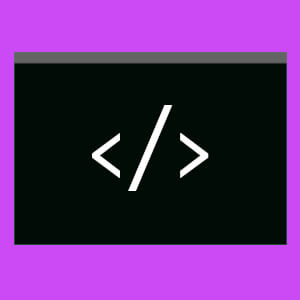


Hypertext Markup Language (HTML), is a computer programming language that was invented by physicist Tim Berners-Lee in 1990 to create and display pages on the world wide web. Special computer programs called internet browsers (hint: you're using one now) are programmed to read and interpret HTML files, which tell the browsers what information to display and how to display it.
HTML is written by using HTML tags, words or abbreviations placed between a greater-than sign (<) and a less-than sign (>). The letters in these tags let browsers know what type of information to expect and how to display it on the screen. For example, to write a heading, like the one above this paragraph, the HTML tag is: <h3>What Is HTML?</h3>.
Here is a list of some common HTML tags and what they mean:
<h1></h1> stands for "heading 1" and is the largest size heading. Like we've already seen, there are also other, smaller heading tags from h2-h4.<p></p> stands for "paragraph" and is used wherever normal text is needed.<b></b> stands for "bold" and is used to make text bold, helping it stand out.<img src="https://www.experimonkey.com/favicon.ico"> stands for "image" and you might've noticed this tag is a little different from the ones above. First off, the <img> tag doesn't have a closing tag, or a second part tag with a slash (/) inside of it. It also has something called an attribute, the part that begins with src=. Attributes are used to give the browser additional pieces of information. Here, the src attribute stands for "source" and tells the browser the URL of the image to display.
Now, for the fun part. In the input box below, you can try writing your own HTML code. Let's start off by writing a heading. Try typing <h2>I'm writing HTML!</h2> and see what happens.
Among numerous other awards, including the Turing Award—kind of like the Nobel Prize for computer science—in 2004 Tim Burners-Lee received a ceremonial knighthood from Queen Elizabeth II for his work in advancing computer science. You can now refer to him as "Sir" Tim Burners-Lee.
Out of the approximately 1.1 billion websites that exist, about 82% are inactive, meaning they haven't been updated for a long time. That still leaves over 200 million websites that are regularly updated. Because websites can exist without having their own domain name (like experimonkey.com or google.com), it's also estimated that there are about 400 million domains currently registered.
When Tim Burners-Lee created HTML and the web in 1991, his first project open to the public was a bare-bones website with a collection of scientific papers, hosted on his personal NeXT computer. The first release of HTML, HTML 1.0, didn't even support images! It wasn't until later in the 90s that the web started to be used for other purposes, such as websites for businesses and organizations.
New releases of HTML are overseen by the the World Wide Web Consortium (W3C), an international organization founded by Tim Burners-Lee in 1994. Some of the new features of HTML5 include improved support for multimedia, better accessibility for users with disabilities, and new functionality for creating dynamic web applications. HTML5 also includes new elements which allow developers to more easily create web pages that are better structured for both humans and search engines to understand.
The world's first website was published on August 6, 1991 by Tim Berners-Lee, then working at CERN, the European Organization for Nuclear Research. You can still visit it at its original URL, http://info.cern.ch/hypertext/WWW/TheProject.html.
The website is a basic HTML document providing information about the World Wide Web project, which aimed to make it easier for people to access and share information online. Even though HTML has come a long way since, with most sites having colorful and interactive pages, it goes without saying that HTML is here to stay.